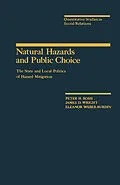Natural Hazards and Public Choice: The State and Local Politics of Hazard Mitigation presents a research project that emerged from a concern for estimating the balance of support versus opposition to prospective social policies that aim to reduce the risks of damage or injuries from major natural hazard events via the regulation of land use and establishment of building and occupancy standards in high-risk areas. The volume begins with an overview of the research project and the main findings. Separate chapters describe the study design; assess the views of politically influential people regarding the seriousness of natural hazards; measure the support for federal disaster policies; and consider public opinion on hazards-mitigation issues in California. Subsequent chapters cover the National Flood Insurance Program (NFIP); patterns of activity, influence, and power among key positions and groups in local communities with respect to issues involving disasters; and hazard mitigation activities at the state level.
Inhalt
Preface
List of Tables
1 Policy, Politics, and Natural Hazards: An Overview of Themes and Findings
The Study
The Policy Options
The Salience of Natural Hazards
Support for Policy Alternatives
Popular Assessments of Hazards and Hazard Policies
Elite Appraisals of the NFIP
Patterns of Interest, Group Activity, and Power
Summary
2 The Study Design
Defining the Universe
Sampling States
Sampling Local Communities
Selecting Potential Respondents
Interviewing Elites
Who are the Elite?
The California Resident Survey
3 How Important are Natural Hazards Problems to State and Community Elites?
Perceived Seriousness of Natural Hazards
Other Serious Problems Mentioned
Do Some Care More than Others?
Why Some Care
Variation in Hazard Seriousness among States
Variation in Hazard Seriousness among Local Communities
Perceived Hazard Seriousness: Local versus State Elites
Determinants of Individual Seriousness Ratings: Local Elites
Conclusions: on the Seriousness of Natural Hazards
4 Elite Support Levels for Federal Disaster Policy Alternatives
Measuring Support for Global Policy Alternatives
The Mutability of Disaster Policy Preference
Policy Endorsements of Elite Positions
Determinants of Policy Approval by Individuals at the Local Level
Results by States and Local Communities
Assessments of Specific Hazard-Management Programs
Summary and Conclusions
5 Popular Assessments of Hazards and Hazards Policies: The Case of California's Nine Communities
Californians' Ratings of Hazard Seriousness
Levels of Disaster Preparedness
Attitudes toward Federal Hazard-Management Policies
Conclusions
6 Elite Appraisals of the NFIP
Background
Legislation Relevant to the National Flood Insurance Act of 1968
Community Participation
The Role of the Government
The Reactions of State Elites
State Floodplain Regulations and NFIP
State versus Local Elites: Mean Opinions, by State
The Reactions of Local Elites
The Problems, Controversies, and Future of the NFIP
Summary and Conclusions
7 Patterns of Interest and Power in Nonstructural Hazard-Mitigation Politics in Local Communities
Levels of Local Community Activity, by Group and Position
Patterns of Influence
Regular Contact with Groups
Elite Favorability toward Nonstructural Hazard-Mitigation Measures
Who Influences the Elites?
Who Influences City Hall?
Summary and Conclusions
8 Patterns of Group Activity and Power in State Hazard-Mitigation Legislation
Activity Levels
Correlates of Cluster Activity Levels
Perceived Importance of Groups and Positions
Favorability toward Nonstructural Hazard-Mitigation Legislation
Elite Contacts with Groups and Positions
Influences on Respondents
Summary and Conclusions
Appendix A. Survey of Natural Disaster Public Policies: Key Persons Interview Schedule
Appendix B. Survey of Natural Disaster Public Policies: Household Residents Interview Schedule
References
